Colorful Clues: The Magical World of Chemical Indicators |ChemFam #63|
Greetings to everyone! Imagine you're in a chemistry laboratory, conducting an experiment. You mix two clear liquids together, and suddenly, the solution changes color from transparent to bright pink. What just happened? Well, you've just witnessed the magic of chemical indicators in action! These remarkable substances play a pivotal role in the world of chemistry, helping scientists and enthusiasts alike decipher the invisible language of chemicals. Let's delve into a colorful journey through the captivating world of chemical indicators, exploring their significance, history, and the remarkable ways they impact our daily lives.
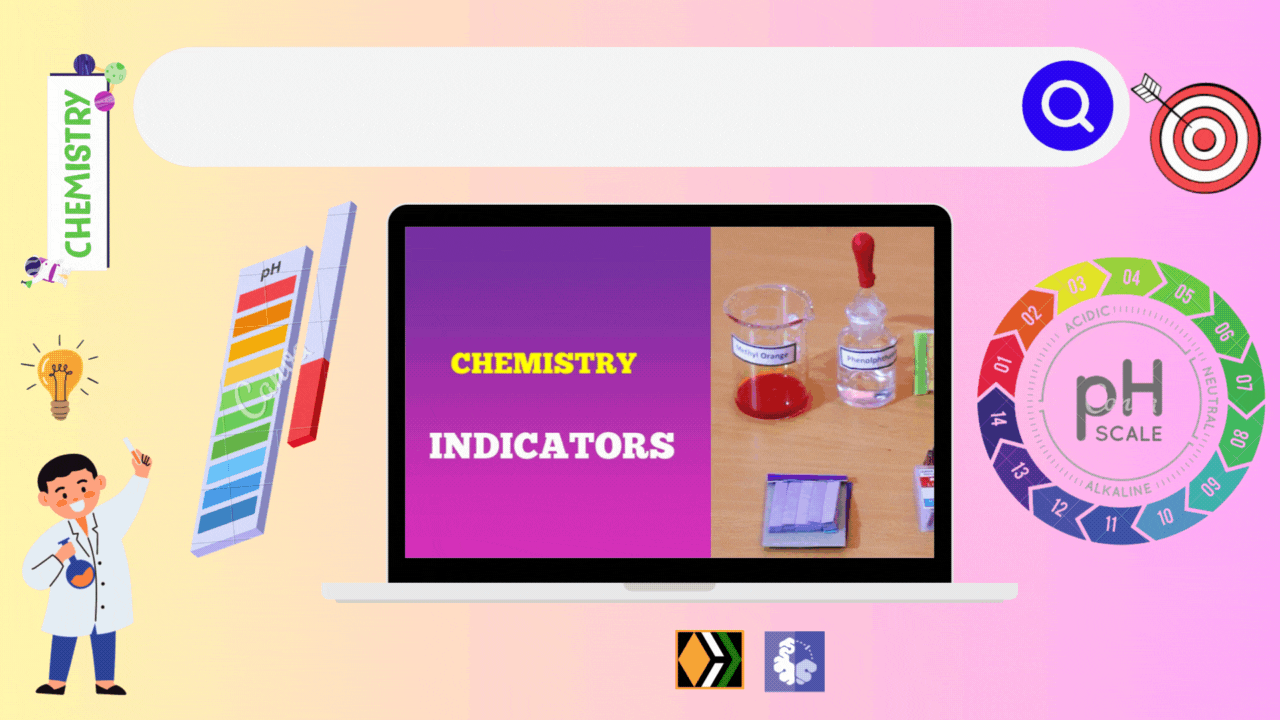
What are Chemical Indicators?
Any substance that visually demonstrates the presence or absence of a threshold concentration of a chemical species, such as an acid or base in a solution, usually by changing its color, are called the chemical indicators. thus indicators are weak acids or weak bases that show a change in colour as the concentration of Hydrogen ions in a solution changes or the pH of a solution changes. The indicators dissociate slightly in the water to form ions. They are a chemist's version of a magic crystal that gives us a glimpse into the beautiful dance of molecules and atoms that make up our world. For example, a chemical called methyl yellow gives an alkaline solution a yellow color. When acid is added slowly, the solution remains yellow until all bases are neutralized, at which time the solution turns red.
A Peek into the Past
The story of chemical indicators stretches back through the annals of time, with some of the earliest instances hailing from ancient civilizations. Back in the day, the Egyptians and later, alchemists of the Middle Ages, used something known as litmus paper, which was derived from lichens. This rudimentary pH indicator was a precursor to the dazzling array of chemical indicators we rely on today.
One of the key figures in the world of chemical indicators was Carl Wilhelm Scheele, a Swedish chemist of the late 18th century. Scheele is credited with discovering litmus and other early indicators, setting the stage for the development of the sophisticated pH testing methods we have today. As we move into the 20th century, the likes of Arnold Beckman revolutionized the field with the invention of the pH meter, allowing for precise and automated pH measurements.
What's in The World of pH
At the heart of chemical indicators lies a simple concept - pH. pH (stands for potential of hydrogen) is a measure of how acidic or alkaline a solution is, with values ranging from 0 to 14. A pH of 7 is considered neutral, below 7 is acidic, and above 7 is alkaline. Chemical indicators respond to changes in pH by changing their color, providing a vivid and engaging way to understand a solution's chemical nature.
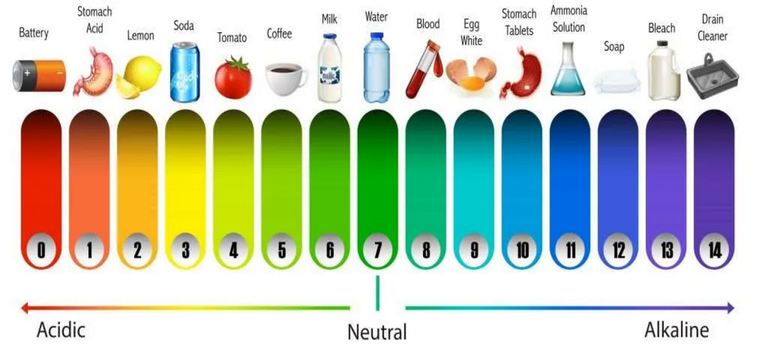
Types of Indicators
Indicators could be divided into two classes- artificial and natural. Although a third class of indicators are also seen. these are called olfactory indicators, as the name itself suggests, yes you are right! this class of indicators do not show a color change but a change in smell when added to acid or a base.
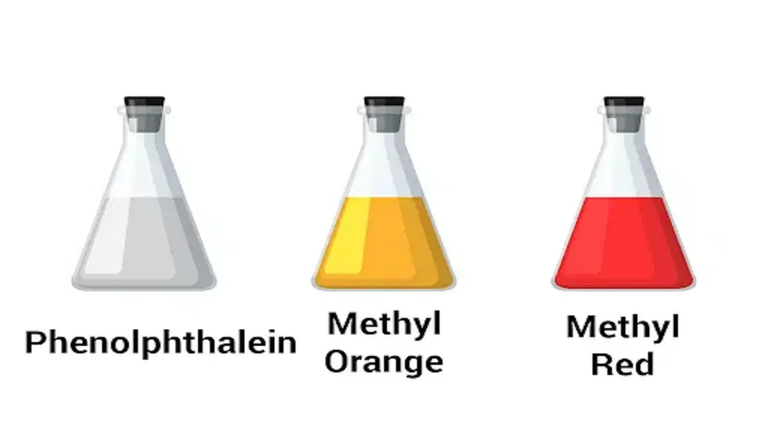
Natural indicators that occur naturally in the environment and can be used to detect whether a material is acidic or basic and examples are litmus, red cabbage, grape juice, turnip peel, curry powder and turmeric etc. Whereas those of the artificial ones are prepared through chemical reactions and prepared in the laboratory. Examples includes the famous phenolphthalein, Methyl orange etc.
Let us discuss each of the three in a bit more detail.
Natural Indicators
Natural Indicator is a sort of indicator that may be found in nature and can be used to detect whether a material is acidic or basic. For example, hydrangeas can tell you whether your soil is acidic or alkaline. The flowers turn blue if the soil is acidic, purple if the soil is neutral, and red if the soil is alkaline. Color strength is determined by the amount of acid or alkali in the soil. Dark blue flowers bloom in highly acidic soils and dark purple flowers bloom in strongly alkaline soils.
Let's see two of the most commonly used natural indicators-
- Litmus: Litmus is obtained from lichens and is a mixture of water-soluble dyes obtained from lichens. Litmus is usually converted into a soluble color that is absorbed into a paper called litmus paper. The natural color of litmus is purple. Litmus can be used to test whether it is an acid or a base. Red litmus paper turns blue in alkaline solution and does not change color in acid. Blue litmus paper turns red in acid, but does not change color in alkaline solution. Neutral litmus turns red and blue in acidic and alkaline solutions, respectively.
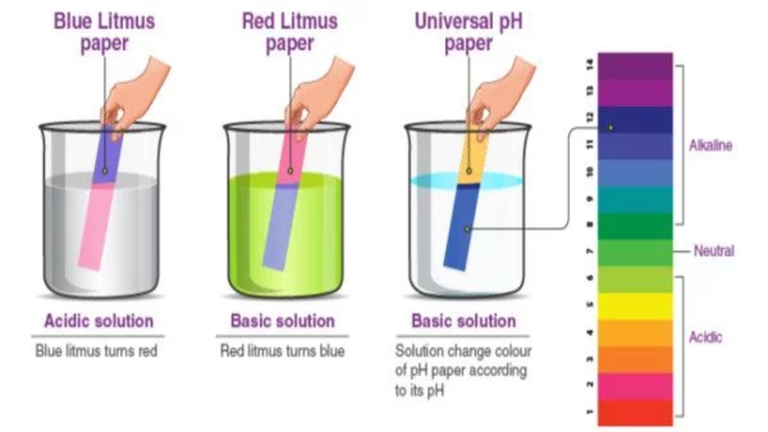
- Turmeric: Turmeric is commonly known as Haldi. Color is bright yellow. Turmeric paste can be used to test for sample's acidity or basicity. In an acidic environment, turmeric has a yellow color and does not change color, while in an alkaline solution its color turns red.
Artificial (or Synthetic) Indicators
Artificial or synthetic indicators are acid-base indicators made from chemical compounds.
Some artificial or synthetic products discussed below are:
- Methyl Orange: Methyl Orange is also an indicator and shows color change in acids and bases . Its original color is orange. Methyl orange should only be used in the presence of mineral acids and strong bases. It does not recognize weak acids and bases. Methyl orange turns orange red in acidic medium and yellow in alkaline medium. The structure of methyl orange is as shown below:
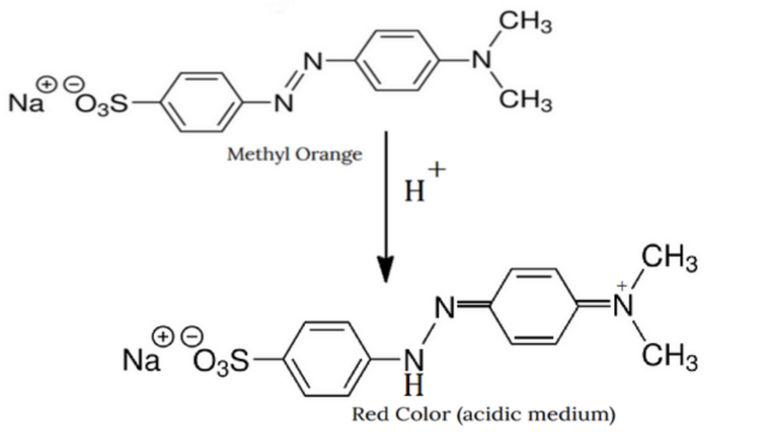

- Phenolphthalein: Phenolphthalein is a water-soluble dye and is dark purple in color. It is used in form of a solution to test for acid and base. In an acidic medium, it turn colorless while in a basic medium it turns light pink in color. It is mostly used in acid-base titrations. The color of phenolphthalein is shown below in acidic and basic medium:
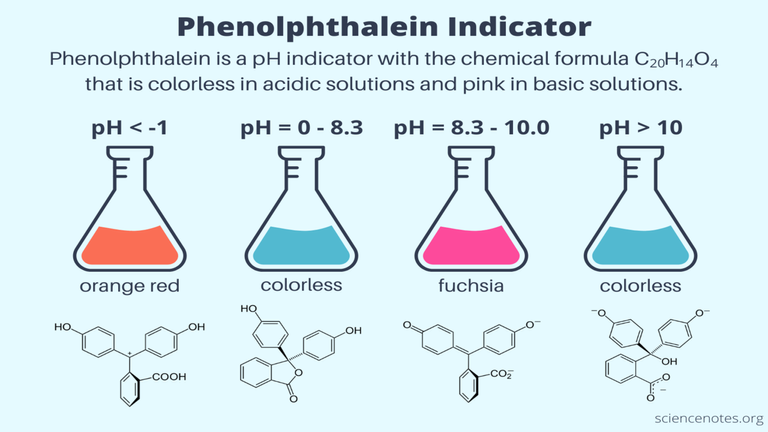
Olfactory Indicators:
Olfactory indicator is a chemical whose odor changes depending on its combination with acid or alkali. In the laboratory, odor testing can be used to determine whether a solution is basic or acidic, through a process called olfactory titration. Simply defined, olfactory markers are compounds that have different odors in acids and solutions. For example vanilla extract, onion clove oil etc. All of them have a special aroma. Olfactory indicators are useful for visually impaired students in identifying acids or bases.
Some olfactory indicators are as follows:
Onion Extract: Onion extract is obtained by boiling water and adding chopped onion into it. When the water cools down, the onion extract is ready. Onion extracts shows changes of smell in acid and base. It retains its pungent smell when added to acid, but in the base it has no odor at all.
Vanilla Extract: The vanilla extract works similarly to onion extract. It maintains its pleasant smell in acid, and loses its smell in alkaline environment.
| Indicators | Color in Acid | Color in Base |
|---|---|---|
| Methyl orange | Red | Yellow |
| Phenolphthalein | Colourless | Pink |
| Litmus | Red | Blue |
| Turmeric | No change | reddish Brown |
| Red cabbage Extract | Red | Bluish green |
| Onion Extract | retains its smell | Becomes odourless |
| Vanilla Extract | retains its smell | loses its smell |
What are the Universal Indicators?
The common indicators may or may not show colour change over a wide range of pH but only for a small range. This makes it difficult to identify the acids or bases. This problem is solved by universal indicators. Multiple indicators are mixed to form universal indicator which change their colour over a wide range of pH values.
Everyday Enchantments
The magic of chemical indicators doesn't stay confined to laboratories; it's all around us, enhancing our daily experiences:
Swimming Pools: Chemical indicators help maintain the perfect pH balance in pools and hot tubs, ensuring our aquatic adventures are both safe and enjoyable.
Household Cleaning: Many cleaning products rely on pH indicators to find the right pH balance for tackling various surfaces, making your cleaning efforts more effective.
Gardening: Green thumbs use pH testing kits to understand and adjust soil acidity, ensuring their plants thrive and bloom.
Food Production: The food industry employs pH testing to monitor the acidity of foods and beverages, guaranteeing the flavors and safety of what we consume
Importance of indicators
Information products are very important in business biology, chemistry, civil engineering, water treatment, agriculture, forestry, food science, environmental science, water treatment, ocean water, medicine, food and agricultural science.
Lichens can be used as litmus. It is a mixture of water-soluble colors. It is then absorbed into filter paper to form the first pH indicator used to determine the acidity or alkalinity of a substance.
Conclusive thoughts
Chemical indicators are like nature's color-changing storytellers, revealing the hidden chemistry of the world around us. From ancient origins to modern applications, these enchanting substances have played a pivotal role in scientific discovery and our daily lives. So, next time you witness a color transformation in your surroundings, take a moment to appreciate the wonder of chemical indicators, for they are the magic-makers, illuminating the hidden secrets of the chemical universe.
Until we meet again :)

Chemical indicators- definition, examples and facts
Chemical indicators- an overview, ScienceDirect
Colloids in Action: Impacting Your Daily Life More Than You Think |ChemFam #62|
The Complex Landscape of Opioid Analgesics: Addressing The Concerns |ChemFam #61|
Genetic Engineering: Pioneering Progress or Ethical Predicament? |ChemFam #60|
The Guardians Against Microbial Menace: Antibacterial Agents |ChemFam #59|
The Cholesterol Conundrum: The Story of Statins |ChemFam #58|
Unveiling The Control Of Chemistry: How Hormones Dictate Our Mood |ChemFam #57|
Thermodynamic Versus Kinetic Control of Reactions |ChemFam #56|
Bosons: The Quantum Glue That Holds The Universe Together |ChemFam #55|
Extraction of Lithium Using Electrode Materials of Lithium Ion Battery-II |ChemFam #54|
Extraction of Lithium Using Electrode Materials of Lithium Ion Battery |ChemFam #53|
Helium: The First Noble Gas |ChemFam #52|
Hydrogen: The Simplest Atom |ChemFam #51|
Elements, Atoms and Atomic Theory |ChemFam #50|
Have You Thanked A Clod Today? |ChemFam #49|
Nuclear Energy: Will It Rise Again? |ChemFam #48|
Soaps: An Essential and Effective Cleansing Agent |ChemFam #47|
Chemicals in Food : Debunking Myths and Ensuring Safe Consumptions |ChemFam #46|
Unveiling The Secrets of Antiseptics and Disinfectants |ChemFam #45|
What are Antimicrobials and Antimicrobial Drugs? |ChemFam #44|
Therapeutic Action of Different Classes of Drugs |ChemFam #43|
PS The thumbnail image is being created by me using canva.com


!PGM
BUY AND STAKE THE PGM TO SEND A LOT OF TOKENS!
The tokens that the command sends are: 0.1 PGM-0.1 LVL-0.1 THGAMING-0.05 DEC-15 SBT-1 STARBITS-[0.00000001 BTC (SWAP.BTC) only if you have 2500 PGM in stake or more ]
5000 PGM IN STAKE = 2x rewards!
Discord
Support the curation account @ pgm-curator with a delegation 10 HP - 50 HP - 100 HP - 500 HP - 1000 HP
Get potential votes from @ pgm-curator by paying in PGM, here is a guide
I'm a bot, if you want a hand ask @ zottone444
Thanks for your contribution to the STEMsocial community. Feel free to join us on discord to get to know the rest of us!
Please consider delegating to the @stemsocial account (85% of the curation rewards are returned).
Thanks for including @stemsocial as a beneficiary, which gives you stronger support.
Thank you @stemsocial
This post has been manually curated by @bala41288 from Indiaunited community. Join us on our Discord Server.
Do you know that you can earn a passive income by delegating to @indiaunited. We share more than 100 % of the curation rewards with the delegators in the form of IUC tokens. HP delegators and IUC token holders also get upto 20% additional vote weight.
Here are some handy links for delegations: 100HP, 250HP, 500HP, 1000HP.
100% of the rewards from this comment goes to the curator for their manual curation efforts. Please encourage the curator @bala41288 by upvoting this comment and support the community by voting the posts made by @indiaunited.
Thank you @bala41288 and @indiaunited